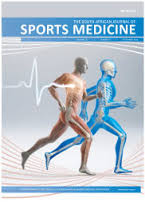Regional morphological adaptations of vastus lateralis muscle in response to different progressive resistance training programs: A randomised controlled trial
DOI:
https://doi.org/10.17159/2078-516X/2024/v36i1a18549Abstract
Background: Resistance training often increases muscle size, a phenomenon known as muscle hypertrophy. These morphological adaptations were typically documented to occur in a non-uniform pattern. Investigating the specific morphological adaptations to different training programs was of interest.
Objectives: This study aimed to investigate two resistance training programs, a high-intensity program (HI) and a combined high-intensity with low-intensity blood flow restriction program (MIX), on morphological adaptations of vastus lateralis muscle in healthy young men.
Methods: Eighteen active participants were recruited and randomly assigned to the HI (n = 10) or MIX (n = 8) groups, undergoing different 6-week resistance training programs. The training volume set was equated and progressively increased from three sets in weeks 1 and 2 to six sets, and eight sets in weeks 3-4 and 5-6, respectively. Three specific regions of vastus lateralis were assessed by magnetic resonance imaging (MRI) and ultrasound imaging (US) during pre-and post-intervention.
Results: Statistical analysis revealed statistically significant increases in muscle area at the proximal (HI: ∆12%, MIX: ∆9.2%), middle (HI: ∆8.7%, MIX: ∆9.0%), and distal (HI: ∆14%, MIX: ∆13%) regions. Additionally, both HI and MIX groups showed statistically significant increases in the sum of muscle thickness post-intervention (HI: ∆12%, MIX: ∆19%) and in the sum of fascia thickness post-intervention (HI: ∆27%, MIX: ∆54%). Despite the MIX group training with higher volume load, no statistical differences were observed between groups for any week.
Conclusion: These findings suggested that both HI and MIX programs effectively induced increases in muscle area and sums of muscle and fascia thickness in healthy young men, allowing practitioners to choose either program based on individual preferences and constraints.
Downloads
Downloads
Published
Issue
Section
License
Copyright (c) 2024 South African Journal of Sports Medicine

This work is licensed under a Creative Commons Attribution 4.0 International License.
The South African Journal of Sports Medicine reserves copyright of the material published. The work is licensed under a Creative Commons Attribution 4.0 (CC BY 4.0) International License. Material submitted for publication in the South African Journal of Sports Medicine is accepted provided it has not been published elsewhere. The South African Journal of Sports Medicine does not hold itself responsible for statements made by the authors.
How to Cite
- Abstract 372
- PDF 249






.png)